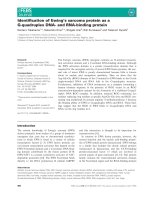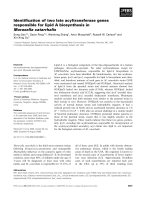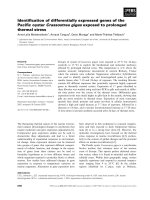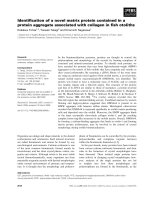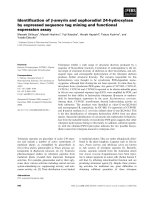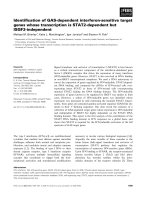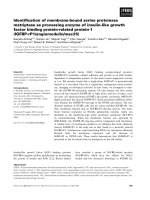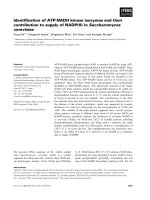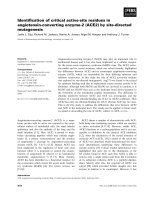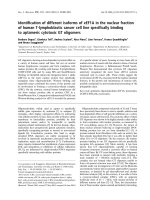Báo cáo khoa học: Identification of novel carbohydrate modifications on Campylobacter jejuni 11168 flagellin using metabolomics-based approaches docx
Bạn đang xem bản rút gọn của tài liệu. Xem và tải ngay bản đầy đủ của tài liệu tại đây (252.28 KB, 10 trang )
Identification of novel carbohydrate modifications
on Campylobacter jejuni 11168 flagellin using
metabolomics-based approaches
Susan M. Logan
1
, Joseph P. M. Hui
2
, Evgeny Vinogradov
1
, Annie J. Aubry
1
, Jeremy E. Melanson
2
,
John F. Kelly
1
, Harald Nothaft
1
and Evelyn C. Soo
2
1 NRC-Institute for Biological Sciences, Ottawa, Canada
2 NRC-Institute for Marine Biosciences, Halifax, Canada
Campylobacter is an important human pathogen and
the most prevalent causative agent of bacterial gastro-
enteritis worldwide, with Campylobacter jejuni repre-
senting over 90% of all Campylobacter infections [1].
Most cases of Campylobacter infections are sporadic
and can be traced to the consumption of undercooked
(or the handling of) contaminated chicken, but out-
breaks, although rare, do occur mainly as a result of
the consumption of contaminated sources of water or
unpasteurized milk [2]. Although the majority of cases
of Campylobacteriosis are self-limiting, complications
can occur and these range in severity from bloody
diarrhoea and fever lasting over 1 week, to more
severe and life-threatening conditions, such as the
Keywords
Campylobacter; flagellin; glycosylation;
metabolomics; pseudaminic acid
Correspondence
E. C. Soo, MS Metabolomics Group,
NRC-Institute for Marine Biosciences,
1411 Oxford Street, Halifax, NS B3H 3Z1,
Canada
Fax: +1 902 426 9413
Tel: +1 902 426 0780
E-mail:
(Received 22 September 2008, revised 3
December 2008, accepted 5 December
2008)
doi:10.1111/j.1742-4658.2008.06840.x
It is well known that the flagellin of Campylobacter jejuni is extensively gly-
cosylated by pseudaminic acid and the related acetamindino derivative, in
addition to flagellin glycosylation being essential for motility and coloniza-
tion of host cells. Recently, the use of metabolomics permitted the unequiv-
ocal characterization of unique flagellin modifications in Campylobacter,
including novel legionaminic acid sugars in Campylobacter coli, which had
been impossible to ascertain in earlier studies using proteomics-based
approaches. To date, the precise identities of the flagellin glycosylation
modifications have only been elucidated for C. jejuni 81-176 and C. coli
VC167 and those present in the first genome-sequenced strain C. jejuni
11168 remain elusive due to lability and respective levels of individual gly-
can modifications. We report the characterization of the carbohydrate
modifications on C. jejuni 11168 flagellin using metabolomics-based
approaches. Detected as their corresponding CMP-linked precursors, struc-
tural information on the flagellin modifications was obtained using a com-
bination of MS and NMR spectroscopy. In addition to the pseudaminic
acid and legionaminic acid sugars known to be present on Campylobacter
flagellin, two unusual 2,3-di-O-methylglyceric acid modifications of a nonu-
losonate sugar were identified. By performing a metabolomic analysis of
selected isogenic mutants of genes from the flagellin glycosylation locus of
this pathogen, these novel CMP-linked precursors were confirmed to be
di-O-methylglyceric acid derivatives of pseudaminic acid and the related
acetamidino sugar. This is the first comprehensive analysis of the flagellar
modifications in C. jejuni 11168 and structural elucidation of di-O-methyl-
glyceric acid derivatives of pseudaminic acid on Campylobacter flagellin.
Abbreviations
HILIC, hydrophilic interaction liquid chromatography; HMBC, heteronuclear multiple bond correlation; Pse, pseudaminic acid.
1014 FEBS Journal 276 (2009) 1014–1023 ª 2009 The Authors Journal compilation ª 2009 FEBS
post-infection neuropathy Guillain–Barre
´
Syndrome [3]
and rare malignant lymphomas of the small intestine
known as immunoproliferative small intestine disease
[4].
Flagellae comprise an important virulence factor of
many bacterial pathogens that confers motility and
allows colonization of host cells. In Campylobacter, the
major structural protein FlaA must be glycosylated for
flagellar filament assembly [5] and, given the impor-
tance of motility in infectivity, there is tremendous
potential to target the flagellin glycosylation process in
the development of novel antimicrobial therapies [6].
For some time, there have been extensive studies on
flagellin glycosylation in Campylobacter in terms of the
identification of the glycosyl moieties present on the
flagellar protein and the genes involved in the bio-
synthetic process. The complete genome sequence of
C. jejuni 11168 published in 2000 [7] revealed a flagel-
lin glycosylation locus consisting of approximately 50
genes, and included genes that displayed significant
homology to sialic acid biosynthesis genes. Studies
using proteomics-based methods identified the
5,7-di-N-acetylated derivative of 5,7-diamino-3,5,7,
9-tetradeoxy-l-glycero-l-manno-nonulosonic acid [5,7-
di-N-acetyl-pseudaminic acid (Pse), Pse5Ac7Ac] and its
acetamidino derivative to be the major glycosyl modifi-
cations on C. jejuni 81-176 flagellin in addition to
minor amounts of two related glycans (Pse5Ac7A-
c8OAc, Pse5Ac7Ac8O-GlnAc) [8,9]. Campylobac-
ter coli VC167 flagellin was also shown to contain
Pse5Ac7Ac, as well as two other novel legionaminic
acid derivatives that were not found on flagellin from
C. jejuni 81-176. These novel legionaminic acid deriva-
tives were synthesized exclusively by the ptm genes,
which were present within the flagellar glycosylation
locus of this strain [10]. However, due to the labile nat-
ure of many of these carbohydrate modifications and
their considerably low abundance on the flagellin pro-
tein, attempts to characterize the precise structures of
many of these observed carbohydrates using the estab-
lished proteomics-based approaches were unsuccessful.
In addition, although the identification of biosynthetic
genes had been made via mutagenesis studies [5], the
functional characterization of the flagellar glycan bio-
synthetic enzymes and nonulosonate sugar pathways
was poorly described.
Metabolomics has recently emerged as an invalu-
able tool for the study of poorly characterized meta-
bolic pathways. In the first metabolomic study of
Campylobacter, a targeted metabolomic screen of
C. jejuni 81-176 revealed the tremendous potential for
using metabolomics to identify unknown substrates
and elucidate the role of genes in the biosynthesis of
the novel flagellin glycan structures [11]. This work
led to expanded studies of the flagellin glycosylation
locus in Campylobacter [12,13] and highlighted the
innovative use of metabolomics as an alternative to
proteomics-based approaches [8–10,14] to gain precise
structural information on novel carbohydrate moieties
that glycosylate the flagellar protein. The use of
hydrophilic interaction liquid chromatography (HI-
LIC)-MS in these recent studies was critical because
it allowed discrimination of metabolites with the same
mass-to-charge (m ⁄ z) ratios, which would otherwise
be indistinguishable using MS alone. The HILIC-MS
method allowed the separation of complex mixtures
of CMP-linked nonulosonic acids and the large-scale
purification of these novel metabolites for NMR
analysis. The resolution afforded by HILIC for
sugar-nucleotides ultimately led to the unexpected
identification of a family of legionaminic acid sugars
in C. coli VC167, which had previously been thought
to be derivatives of Pse [10,13].
As noted earlier, in contrast to C. jejuni 81-176 and
C. coli VC167, there is much less knowledge of the fla-
gellin glycosylation process and the precise nature of
the flagellar glycans of genome-sequenced strain C. je-
juni 11168. Comparative analysis of the flagellin glyco-
sylation locus of these three strains shows the presence
of genes known to be involved in the biosynthesis of
Pse [15] legionaminic acid [13] and related derivatives
in C. jejuni 11168. It is noteworthy that the flagellin
glycosylation locus of C. jejuni 11168 is more complex
than either C. jejuni 81-176 or C. coli VC167, suggest-
ing a genetic potential for C. jejuni 11168 to glycosy-
late its flagellin with additional novel glycans. Given
the relative ease of gaining precise structural informa-
tion on unique flagellin modifications using metabolo-
mics approaches [12,13], the present study provides a
comprehensive study of the flagellar glycan structures
of C. jejuni 11168 flagellin.
Results
Metabolomic analysis of wild-type C. jejuni 11168
The metabolome of wild-type C. jejuni 11168 was
screened for potential biosynthetic sugar-nucleotides
relating to the carbohydrate moieties found on its fla-
gellin using an established HILIC-MS method [12].
During precursor ion scanning for ions characteristic
of CMP (m ⁄ z 322), an intracellular pool of eight
CMP-linked sugars was detected within cell lysates of
the wild-type strain (Fig. 1). Upon closer examination
of these CMP-linked sugars, it was observed that the
retention times of six of the CMP-linked sugars and
S. M. Logan et al. Flagellin glycosylation in C. jejuni
FEBS Journal 276 (2009) 1014–1023 ª 2009 The Authors Journal compilation ª 2009 FEBS 1015
their corresponding m ⁄ z values were consistent with
those obtained in earlier metabolomic studies of
C. jejuni 81-176 and C. coli VC167 [12,13], identify-
ing these metabolites as the CMP-linked precur-
sors of Pse5Ac7Ac, Pse5Ac7Am, Leg5Ac7Ac,
Leg5Am7Ac, Leg5MeAm7Ac and Neu5Ac (Leg is
5,7-diamino-3,5,7,9-tetradeoxy-d-glycero-d-galacto-non
ulosonic acid). The presence of these CMP-linked pre-
cursors in C. jejuni 11168 is not surprising because
the genes known to be involved in their biosynthesis
in C. jejuni 81-176 (Pse5Ac7Ac, Pse5Ac7Am and
Neu5Ac) or C. coli VC167 (Leg5Ac7Ac, Leg5Am7Ac,
Leg5MeAm7Ac) are also present in the 11168 strain.
However, in addition to these well-characterized
CMP-linked intermediates, two unknown CMP-linked
precursors were also observed in the metabolome of
C. jejuni 11168. As shown in Fig. 1, one of these
novel CMP-sugars was detected at 13.6 min as
[M ) H]
)
ions at m ⁄ z 712, whereas the second novel
CMP-sugar was observed at 17.3 min at m ⁄ z 711. In
the positive mode, oxonium ions corresponding to
these novel CMP-linked sugars are produced and
these were observed as precursor ions at m ⁄ z 714 (I)
and m ⁄ z 713 (II) (data not shown).
MS analysis of 11168 flagellin glycopeptides
To confirm that the corresponding glycan moieties of
these novel CMP-sugars (m ⁄ z 711, 389 Da; m ⁄ z 712,
390 Da) were actually present on the flagellin protein
of C. jejuni 11168, flagellin glycopeptides were analysed
by LC-MS ⁄ MS following enzymatic digestion of flagel-
lin protein. The presence of the oxonium ions m ⁄ z 390
and 391, which correspond to glycans of mass 389 and
390 Da on two flagellar glycopeptides, is indicated in
Fig. 2. These two glycan modifications were the most
abundant modification found on all flagellin glycopep-
tides examined (data not shown).
Structural analysis of I and II by high
resolution MS
The HILIC-MS and precursor ion scanning method
provides a highly selective means for detecting sugar-
Fig. 1. Intracellular CMP-sugars detected in parent strain C. jejuni
11168 by HILIC-MS and precursor ion scanning for fragment ions
related to CMP (m ⁄ z 322).
Fig. 2. NanoLC-MS ⁄ MS analysis of the tryptic digest of 11168 fla-
gellin. (A) MS ⁄ MS spectrum of the doubly charged ion at m ⁄ z
1167.1 corresponding to the glycopeptide, T
203–222
, modified with a
single glycan moiety. The amino acid sequence of this peptide is
shown in the inset and the y-fragment ions arising from fragmenta-
tion of the peptide bonds are indicated in the spectrum. This pep-
tide is modified with either the 389 Da or the 390 Da sugar and the
low m ⁄ z region of this spectrum is dominated by their oxonium
ions at m ⁄ z 390.2 and 391.2 (underlined) and related degradation
products. Loss of water molecules from the m ⁄ z 391.2 ion yields
the strong fragment ions at m ⁄ z 373.2 and 355.2, respectively,
whereas the ion at m ⁄ z 346.2 arises from the loss of CO
2
from the
oxonium ion at m ⁄ z 390.2. The ion at m ⁄ z 1943.4 corresponds to
the intact peptide ion (singly charged) having lost the glycan modifi-
cation. (B) MS ⁄ MS spectrum of the doubly charged ion at m ⁄ z
1064.5 corresponding to the glycopeptide, T
463–479
, also modified
with a single glycan moiety. In this instance, the peptide appears to
be modified predominantly with the 389 Da glycan as its oxonium
ion and the related degradation products are dominant. Regions of
both spectra have been expanded to highlight some of the less
abundant but informative fragment ions.
Flagellin glycosylation in C. jejuni S. M. Logan et al.
1016 FEBS Journal 276 (2009) 1014–1023 ª 2009 The Authors Journal compilation ª 2009 FEBS
nucleotides within the metabolome. However, to derive
meaningful structural information on the novel CMP-
sugars and reduce ambiguity, it was necessary to
employ high resolution MS for subsequent experi-
ments. Accurate mass measurements of I and II were
performed on a Waters Q-ToF Premier mass spec-
trometer (Waters Corp., Milford, MA, USA) and
accurate masses of the protonated [M + H]
+
ions of I
and II were revealed as 714.2222 and 713.2403 Da,
respectively (Fig. 3A–C). A database search of the
plausible molecular formulae satisfying these mass
constraints and their isotopic patterns (see Table S1)
suggested an empirical formula of C
25
H
41
N
5
O
17
P (the-
oretical mass = 714.2235 Da, 1.8 p.p.m.) for I and
C
25
H
42
N
6
O
16
P (theoretical mass = 713.2395 Da;
1.1 p.p.m.) for II.
To obtain structural information on these novel
metabolites, a series of tandem MS experiments were
also performed using high resolution MS. In the nega-
tive mode, MS ⁄ MS of the novel sugar-nucleotides
revealed a major fragment ion at m ⁄ z 322, which is
consistent with the expected m ⁄ z for [CMP-H]
)
, sug-
gesting that these novel metabolites are CMP-linked
(data not shown). In the positive mode, MS ⁄ MS of I
and II revealed major fragment ions at m ⁄ z 391.1723
and 390.1887, which correspond to the masses of the
two novel carbohydrate moieties (Fig. 3D,E). To gener-
ate structural information on these carbohydrate moie-
ties, further tandem MS experiments were carried out
to fragment the novel carbohydrates. As shown in
Fig. 4A,B, the second generation product ion spectra
for I and II revealed fragmentation patterns that are
typically observed for nonulosonic acids [9,10,12–14].
For example, characteristic and consecutive neutral
losses of water, ammonia and formic acid were
observed in the second generation product ion spectra
of both I and II. It is noteworthy that a prominent loss
of the acetamidino functionality, CH
3
C(=NH)NH
Fig. 3. Accurate mass measurements of unknown CMP-sugars detected in C. jejuni 11168. (A) Extracted ion chromatogram of m ⁄ z 714 (I)
and 713 (II). (B) MS at 14.6 min showing the accurate mass of I. (C) MS at 17.9 min showing accurate mass of II. (D) Corresponding
MS ⁄ MS spectrum of I. (E) Corresponding MS ⁄ MS spectrum of II.
S. M. Logan et al. Flagellin glycosylation in C. jejuni
FEBS Journal 276 (2009) 1014–1023 ª 2009 The Authors Journal compilation ª 2009 FEBS 1017
(neutral loss of 58 Da), was also observed in the second
generation product ion spectrum of II (Fig. 4B). Based
on our existing knowledge of Campylobacter flagellar
glycans, it is highly plausible that II is the related ace-
tamidino derivative of I because such a feature appears
to be prevalent among the nonulosonic sugars in Cam-
pylobacter (e.g. between Pse5Ac7Ac and Pse5Ac7Am
[12] and Leg5Ac7Ac and Leg5Am7Ac [13]). Interest-
ingly, fragment ions relating to nonulosonic acid were
also apparent in the second generation product ion
spectra of I and II (Fig. 4A,B) [9], suggesting that these
CMP-sugars may be novel derivatives of a nonulosonic
acid. Accordingly, the mass differences of 74.0374 Da
observed between the oxonium ions of Pse5Ac7Ac
(C
13
H
21
N
2
O
7
; theoretical mass = 317.1349 Da) and I,
and of 74.0378 Da observed between Pse5Ac7Am
(C
13
H
22
N
3
O
6
, theoretical mass = 316.1509 Da) and II,
indicate that the novel substituent differs from acetate
by C
3
H
6
O
2
(theoretical mass = 74.0367 Da), thus hav-
ing the overall formula C
5
H
9
O
3
. To unequivocally
assign the structures of I and II, large-scale purifica-
tions of the metabolites were achieved, as described
previously [12,13] for NMR structural elucidation.
Structural analysis of II by NMR spectroscopy
By contrast to the earlier work on C. jejuni 81-176 and
C. coli VC167, the novel CMP-linked metabolites I
and II detected in C. jejuni 11168 were rather unstable
compounds. MS analysis of the purified substrates
revealed that approximately 20 lg of each metabolite
was isolated but, upon their analysis by NMR, it was
observed that degradation of the metabolites had
occurred. This was particularly true for I where com-
plete degradation of the metabolite appeared to have
taken place, and therefore it was only possible to pur-
sue the structural analysis of II by NMR spectroscopy.
In addition to the problem of instability, it was also
observed that the sample contained appreciable
amounts of impurities, including glycerol, lactic acid
and glyceric acid. The presence of these low molecular
weight impurities presented a further challenge with
respect to deducing the precise structure of II by
NMR and attempts to remove these low molecular
mass impurities by gel chromatography were unsuc-
cessful. However, despite these complications, it was
possible to deduce from the NMR spectra spin-systems
of nonulosonic acid, ribose and cytosine (see
Table S2). The coupling constants and chemical
shifts of the nonulosonic acid residue agreed well
with that observed in CMP-5-acetamido-7-ami-
dino-3,5,7,9-tetradeoxy-l-glycero-a-l-manno-nonuloson-
ic acid (CMP-Pse5Ac7Am), which had been detected
in earlier metabolomic studies of the flagellin glycosyl-
ation process in C. jejuni 81-176 [12]. Linkage of Pse
to phosphate was also confirmed by the observation of
H-P coupling on H-3ax (4 Hz). The spectra also con-
tained the characteristic signal of an acetamidine group
(C-1 at 167.4 p.p.m., H ⁄ C-2 at 2.24 ⁄ 19.5 p.p.m.) but
no signals of the acetyl group were observed, suggest-
ing that one of the amino groups of Pse was acylated
by a novel acyl group. The NMR spectra also con-
tained signals of two methyl groups, which gave het-
eronuclear multiple bond correlations (HMBC) with
the signals of the CH and CH
2
groups. Two latter sig-
nals correlated with each other in the COSY spectrum,
but nothing else. These data, taking into account posi-
tion of
13
C signals of these groups (see Table S2) cor-
responded to 2,3-di-O -methyl-glycerate. The COOH
group signal was not observed in HMBC due to its
presence in concentrations below the limit of detection;
thus, the linkage of dimethylglycerate to the nonulo-
sonic acid could not be directly confirmed. However,
Fig. 4. Second generation product ion spectrum of (A) I and (B) II.
Broken arrows indicate the possible neutral loss of the 2,3-di-O-
methyl-glyceramide (C
5
H
11
NO
3
).
Flagellin glycosylation in C. jejuni S. M. Logan et al.
1018 FEBS Journal 276 (2009) 1014–1023 ª 2009 The Authors Journal compilation ª 2009 FEBS
given that the exact theoretical mass of CMP-Pse5acy-
l7Ac (where acyl is 2,3-di-O-methylglycerate) (i.e.
C
25
H
42
N
6
O
16
P
1
) is 713.2395 Da, this proposed deriva-
tive shows a near perfect agreement with the experi-
mentally observed value of 713.2403 Da (1.1 p.p.m.
error). The presence of a dimethylglycerate substituent
would also be consistent with earlier predictions from
the second generation product ion experiments on II
of a novel modification with a molecular formula of
C
5
H
9
O
3
, and, as indicated in the second generation
product ion spectra of I and II (Fig. 4A,B), this could
be observed as the neutral loss of the 2,3-di-O-methyl-
glyceramide (C
5
H
11
NO
3
).
The respective position of the amidine and dimethyl-
glycerate on N-5 and N-7 of the Pse could not be
experimentally confirmed. The HMBC correlations
with C-1 of acyl groups were not observed due to the
low concentration of the purified metabolite II.A
comparison of
13
C chemical shifts of II with model
compounds bearing either two acetyl groups (Pse5A-
c7Ac) or one acetyl group and one amidino group at
N-7 (Pse5Ac7Am) showed good agreement of the
7-amidino derivative with the data for the analyzed
compound (see Table S2). The 7-N-acetyl derivative
had C-7 signal shifted more than 4 p.p.m. upfield com-
pared to that of the 7-amidino derivative. This differ-
ence is characteristic for the amidine substitution and
has been reported also with other sugars [16]. Thus, II
is likely to be substituted with the dimethylglycerate
group at N-5 and with amidine at N-7.
Metabolomic analysis of pseB and pseC Pse
biosynthetic genes
Earlier studies on Pse biosynthesis in Campylobacter
identified key roles for pseB and pseC in the biosyn-
thetic process [12,17,18] and the insertional inactiva-
tion of these two genes had led to the disappearance
of CMP-Pse5Ac7Ac and CMP-Pse5Ac7Am from the
metabolome of C. jejuni 81-176 [12,17,18]. The analysis
of I and II by MS and NMR analyses in the present
study strongly suggests that these two CMP-sugars are
novel modifications of Pse. However, considering the
complexity of the flagellin glycosylation locus of
C. jejuni 11168 and the ability of this strain of Cam-
pylobacter to synthesize both Pse and legionaminic
acid sugars, it would be invaluable to obtain support-
ing biological data to confirm these CMP-sugars as
novel derivatives of Pse. Given that pseB and pseC are
exclusively involved in Pse5Ac7Ac biosynthesis, there
is the potential to employ metabolomics to explore the
sugar-nucleotide complement of isogenic mutants pseB
and pseC of strain 11168, and confirm whether I and
II are indeed novel modifications of Pse. Accordingly,
the metabolomes of isogenic mutants pseB (see
Fig. S1) and pseC (data not shown) of C. jejuni 11168
were prepared and probed for CMP-sugars using the
HILIC-MS and the precursor ion scanning method.
As expected, the CMP-linked precursors of Pse5Ac7Ac
and Pse5Ac7Am were absent from the metabolomes of
both pseB and pseC but, in addition, the novel CMP-
sugars were also no longer present, confirming that I
and II are synthesized through the Pse biosynthetic
pathway. It is noteworthy that the biosynthesis of
the CMP-precursors of the legionaminic acid sugars
was not affected by the insertional inactivation of
pseB and pseC, thereby providing further evidence
that I and II are the dimethylglyceric acid modifica-
tions of Pse and its related acetamidino derivative,
respectively. The absolute configuration of I or II
was not determined. However, the relative configura-
tion of II was determined by NMR. Based on the
structural data obtained by MS and metabolomic
screening of isogenic mutants pseB and pseC, I
was identified tentatively as CMP-7-acetimidoylamino-
5-(2,3-di-O-methylglyceroyl)amino-3,5,7,9-tetradeoxy-l-
glycero-a-l
-manno-nonulosonic acid, and II was
determined to be CMP-7-acetamido-5-(2,3-di- O-
methylglyceroyl)amino-3,5,7,9-tetradeoxy-l-glycero-a-
l-manno-nonulosonic acid (Fig. 5).
Fig. 5. Proposed structures of I and II.
S. M. Logan et al. Flagellin glycosylation in C. jejuni
FEBS Journal 276 (2009) 1014–1023 ª 2009 The Authors Journal compilation ª 2009 FEBS 1019
Discussion
Metabolomics has provided a unique opportunity to
highlight subtle differences in the nature of the glyco-
syl moieties that decorate the flagellin of different
Campylobacter strains through structural elucidation
of their corresponding biosynthetic intermediates. Ear-
lier studies of C. coli VC167 had revealed the potential
for Campylobacter to synthesize a variety of legionami-
nic acid sugars, and this capability was again utilized
in the present study to investigate C. jejuni 11168. In
addition to previously well characterized glycosyl mod-
ifications, two novel carbohydrate modifications were
also detected in the metabolome of C. jejuni 11168 as
their corresponding CMP-linked intermediates. Exten-
sive structural analysis of these CMP-sugars using a
combination of high resolution MS and NMR spec-
troscopy identified these metabolites as the dimethyl-
glyceric acid derivatives of Pse and the related
acetamidino derivative. It is noteworthy that the use of
high resolution MS in the present study was instru-
mental in elucidating the structures of the carbohy-
drate moieties. This was particularly true of I, where
complete degradation of the metabolite had occurred
during NMR analysis and structural information could
only be gained using high resolution MS. Although the
absolute configuration of the novel glycans could not
be determined, the metabolomic analysis of selected
genes known to have an exclusive role in Pse biosyn-
thesis clearly demonstrated a role for these genes in
the biosynthesis of the two novel metabolites, thereby
confirming them as derivatives of Pse.
This is the first report of dimethylglyceric acid deriv-
atives of Pse in Campylobacter and further illustrates
the considerable capacity of Campylobacter to synthe-
size a large number of nonulosonate sugar derivatives.
Although the precise biological role of these novel
derivatives has yet to be defined, a recent study dem-
onstrated that the legionaminic acid biosynthetic genes
present in the Campylobacter flagellar glycosylation
island are a genetic marker for a livestock associated
clade [19]. In addition, legionaminic acid modifications
found on the flagellin of 11168 are involved in the
ability of this strain to persist in the gastrointestinal
tract of chickens (S. L. Howard, A. Jagannathan,
E. C. Soo, J. P. M. Hui, A. J. Aubry, I. Ahmed,
A. Karlyshev, J. F. Kelly, M. A. Jones, M. P. Stevens,
S. M. Logan and B. W. Wren, unpublished results).
By contrast, flagellins from C. jejuni 81-176 are glyco-
sylated with only Pse derivatives [9]. This strain was
originally isolated from a patient during an outbreak
of campylobacteriosis [20] and is highly pathogenic in
monkeys and in human trials [21–23]. The precise role
of the Pse5Ac7Ac and Pse5Ac7Am glycans remains to
be established, but they have been shown to play a key
role in virulence of this strain [24]. The biological role
of the two novel flagellar glycans characterized in the
present study can now also be explored.
Campylobacter is not unique in attaching novel
nonulosonate sugar derivatives to its flagellin. Flagel-
lins from a strain of Campylobacter botulinum,a
Gram-positive spore forming anaerobe, have also been
shown to be glycosylated with a novel legionaminic
acid derivative, 7-acetamido-5-(N-methyl-glutam-4-yl)-
amino-3,5,7,9-tetradeoxy-d-glycero-a-d-galacto-nonulo-
sonic acid (Leg5GluMe7Ac) [25], whereas other strains
appear to produce related structures. It is not yet
known whether these modifications also contribute to
the colonization ability of C. botulinum isolates in
distinct animal hosts.
Experimental procedures
Bacterial strains and growth conditions
C. jejuni 11168 and isogenic mutants pseB and pseC were
grown using the procedure as described previously [12].
Purification of flagellin
Flagellin was purified as previously described [26], although
the solubilization step in 1% SDS was eliminated and the
crude pellet after ultracentrifugation was characterized
directly by MS.
LC-MS/MS analysis of flagellin
Flagellin protein was digested overnight with trypsin (50–
200 lg; Promega, Madison, WI, USA) at a ratio of 30 : 1
(protein : enzyme, v ⁄ v) in 50 mm ammonium bicarbonate
at 37 °C. Protein digests were analyzed by MS as previ-
ously described [10].
Construction of C. jejuni 11168 pseB and pseC
mutant strains
To generate pseB(Cj1293)::cat and pseC(Cj1294)::cat mutants
in C. jejuni 11168, a 4052 bp fragment (dcd-Cj1295) was
amplified by PCR from chromosomal DNA using oligonucle-
otides Pse1 (5¢-ATTTTACACTTTGACTAGGTTGAGC-3¢)
and Pse2 (5¢-ATATTATGCCAAGATTTACAAGTGG-3¢).
The product was inserted into the EcoRV site of plasmid
PCRscript and the SmaI site of plasmid pUC19, resulting in
plasmids PCRscript(pse) and pUC19(pse). A 1.1 kb chloram-
Flagellin glycosylation in C. jejuni S. M. Logan et al.
1020 FEBS Journal 276 (2009) 1014–1023 ª 2009 The Authors Journal compilation ª 2009 FEBS
phenicol-resistance cassette (cat) obtained from SmaI digested
plasmid pRY109 [27] was inserted either into the unique
BseRI (for pseB)orDraIII (for pseC) site, and subsequently
treated with T4 DNA Polymerase, of PCRscript(pse) and
pUC19(pse) to create the knockout plasmids PCR-
script(pseB::cat) and pUC19(pseC::cat). Five micrograms of
Escherichia coli DH5a derived gene knockout plasmid DNA
carrying the cat gene in a nonpolar orientation, as verified by
PCR analyses with primer Pse1 and cat-specific oligonucleo-
tides ccatB (5¢-TTCTGAAAAAACGCCTACCTG-3¢) and
ccatF (5¢-AATGTCCGCAAAGCCTAATC-3¢), was used to
transform C. jejuni 11168 by electroporation, as described pre-
viously [28]. Chloramphenicol-resistant transformants were
characterized by PCR with oligonucleotides ccatF ⁄ 1295-2
(5¢-TGCATATTTAAGATATTGGCTATATCG-3¢) and
ccatB ⁄ 1292-1 (5¢-AACACAAGATGATCGAACCATTTT
GC-3¢) to confirm that the incoming plasmid DNA had inte-
grated by a double cross-over event.
Preparation of cell lysates
Cell lysates of parent strain C. jejuni 11168 and isogenic
mutants pseB and pseC were prepared and extraction of
intracellular sugar-nucleotides from the cell lysates was
achieved using ENVI-Carb (Supelco, Bellefonte, PA, USA)
solid phase extraction cartridges, as described previously
[12].
MS
Cell lysates of parent strain C. jejuni 11168 and isogenic
mutants pseB and pseC were probed for intracellular sugar-
nucleotides using HILIC-MS and a precursor ion scanning
method, as described previously [12]. The intracellular
sugar-nucleotides were separated by HILIC on a TSKgel
Amide80 column (inner diameter 250 · 4.6 mm; Tosoh Bio-
science, Montgomeryville, PA, USA) using an Agilent 1100
Series LC system (Santa Clara, CA, USA) and detected by
precursor ion scanning on a 4000 QTRAP hybrid triple
quadrupole linear ion trap mass spectrometer (AB ⁄ MDS
Sciex, Concord, ON, Canada). For large-scale purifications
of the unknown intermediates, the flow from the LC system
was split 2 : 8 v ⁄ v to the mass spectrometer and the
fractions collected and pooled for subsequent structural
analyses.
For high resolution MS experiments, an Agilent 1100
Series LC system was coupled to a Q-ToF Premier hybrid
quadrupole TOF mass spectrometer equipped with an Elec-
trospray Ionization (ESI) LockSprayÔ modular source
(Waters Corp.). Calibration was performed using the
MS ⁄ MS fragment ions of [Glu
1
]-Fibrinopeptide B (1 pmo-
lÆlL
)1
; Sigma-Aldrich, St Louis, MO, USA) in the positive
mode and a lock mass solution of leucine enkephelin
(100 pgÆlL
)1
; Sigma-Aldrich). A typical mass accuracy of
2 p.p.m. or less was obtained. During data acquisition, the
lock mass solution was infused continuously at a frequency
of 10 : 1 (sample-to-reference ratio). Separations were
achieved using the TSKgel Amide80 column and the same
mobile phase as reported previously [12,13].
The MS data were acquired using the centroid mode.
Tandem MS of the sugar nucleotide molecule was carried
out using argon as collision gas with a collision energy
of 18 eV. To obtain MS ⁄ MS of the sugar molecules, the
cone voltage was increased to 50 V to promote in-source
fragmentation and the resulting sugar oxonium ions were
selected as precursor ions for tandem MS (collision ener-
gy = 20 eV). All data acquisition was performed using
masslynx, version 4.1 (Waters Corp.). Elemental compo-
sition was performed using a mass tolerance of 10 p.p.m.
and was sorted by i-FIT score assigned by masslynx
based on the isotopic patterns of the target ions. The ele-
ments used for searching were limited to C, H, N, O
and P.
NMR spectroscopy
1
H and
13
C NMR spectra were recorded using a Varian
Inova 600 spectrometer (Varian, Palo Alto, CA, USA) with
a cold probe in D
2
O (Cambridge Isotopes Laboratories
Inc., Andover, MA, USA) solutions at 25 °C with acetone
standard (2.23 p.p.m. for
1
H and 31.5 p.p.m. for
13
C) using
standard COSY, TOCSY (mixing time 120 ms), ROESY
(mixing time 200 ms), HSQC and HMBC (100 ms long-
range transfer delay).
Acknowledgements
We would like to thank Dr C. Szymanski, University
of Alberta, for providing pseB and pseC isogenic
mutants of 11168 and Tom Devecseri, NRC-IBS, for
his assistance in preparing the figures.
References
1 Allos BM (2001) Campylobacter jejuni infections: update
on emerging issues and trends. Clin Infect Dis 32, 1201–
1206.
2 Jacobs-Reitsma W, Lyhs U & Wagenaar J (2008)
Campylobacter in the food supply. In Campylobacter
(Nachamkin I, Szymanski CM & Blaser MJ, eds), pp.
627–644. ASM Press, Washington DC.
3 Allos BM (1998) Campylobacter jejuni infection as a
cause of the Guillain–Barre syndrome. Infect Dis Clin
North Am 12, 173–184.
4 Lecuit M, Abachin E, Martin A, Poyart C, Pochart P,
Suarez F, Bengoufa D, Feuillard J, Lavergne A, Gor-
don JI et al. (2004) Immunoproliferative small intestinal
disease associated with Campylobacter jejuni. N Engl J
Med 350, 239–248.
S. M. Logan et al. Flagellin glycosylation in C. jejuni
FEBS Journal 276 (2009) 1014–1023 ª 2009 The Authors Journal compilation ª 2009 FEBS 1021
5 Guerry P, Doig P, Alm RA, Burr DH, Kinsella N &
Trust TJ (1996) Identification and characterization of
genes required for post-translational modification of
Campylobacter coli VC167 flagellin. Mol Microbiol 19,
369–378.
6 Alksne LE (2002) Virulence as a target for antimicro-
bial chemotherapy. Expert Opin Investig Drugs 11,
1149–1159.
7 Parkhill J, Wren BW, Mungall K, Ketley JM, Chur-
cher C, Basham D, Chillingworth T, Davies RM,
Feltwell T, Holroyd S et al. (2000) The genome
sequence of the food-borne pathogen Campylobacter
jejuni reveals hypervariable sequences. Nature 403,
665–668.
8 Schirm M, Schoenhofen IC, Logan SM, Waldron KC
& Thibault P (2005) Identification of unusual bacterial
glycosylation by tandem mass spectrometry analyses of
intact proteins. Anal Chem 77, 7774–7782.
9 Thibault P, Logan SM, Kelly JF, Brisson JR, Ewing
CP, Trust TJ & Guerry P (2001) Identification of the
carbohydrate moieties and glycosylation motifs in Cam-
pylobacter jejuni flagellin. J Biol Chem 276, 34862–
34870.
10 Logan SM, Kelly JF, Thibault P, Ewing CP & Guerry
P (2002) Structural heterogeneity of carbohydrate modi-
fications affects serospecificity of Campylobacter flagel-
lins. Mol Microbiol 46, 587–597.
11 Soo EC, Aubry AJ, Logan SM, Guerry P, Kelly JF,
Young NM & Thibault P (2004) Selective detection and
identification of sugar nucleotides by CE-electrospray-
MS and its application to bacterial metabolomics. Anal
Chem 76, 619–626.
12 McNally DJ, Hui JP, Aubry AJ, Mui KK, Guerry P,
Brisson JR, Logan SM & Soo EC (2006) Functional
characterization of the flagellar glycosylation locus
in Campylobacter jejuni 81-176 using a focused
metabolomics approach. J Biol Chem 281, 18489–
18498.
13 McNally DJ, Aubry AJ, Hui JP, Khieu NH, Whitfield
D, Ewing CP, Guerry P, Brisson JR, Logan SM & Soo
EC (2007) Targeted metabolomics analysis of Campylo-
bacter coli VC167 reveals legionaminic acid derivatives
as novel flagellar glycans. J Biol Chem 282, 14463–
14475.
14 Schirm M, Soo EC, Aubry AJ, Austin J, Thibault P &
Logan SM (2003) Structural, genetic and functional
characterization of the flagellin glycosylation process in
Helicobacter pylori. Mol Microbiol 48, 1579–1592.
15 Schoenhofen IC, McNally DJ, Vinogradov E, Whitfield
D, Young NM, Dick S, Wakarchuk WW, Brisson JR &
Logan SM (2006) Functional characterization of dehy-
dratase ⁄ aminotransferase pairs from Helicobacter and
Campylobacter: enzymes distinguishing the pseudaminic
acid and bacillosamine biosynthetic pathways. J Biol
Chem 281, 723–732.
16 Knirel YA, Paramonov NA, Vinogradov EV, Shashkov
AS, Dmitriev BA, Kochetkov NK, Kholodkova EV &
Stanislavsky ES (1987) Somatic antigens of Pseudomo-
nas aeruginosa.
The structure of O-specific polysaccha-
ride chains of lipopolysaccharides of P. aeruginosa O3
(Lanyi), O25 (Wokatsch) and Fisher immunotypes 3
and 7. Eur J Biochem 167, 549–561.
17 Schoenhofen IC, Lunin VV, Julien JP, Li Y, Ajamian
E, Matte A, Cygler M, Brisson JR, Aubry A, Logan
SM et al. (2006) Structural and functional characteriza-
tion of PseC, an aminotransferase involved in the bio-
synthesis of pseudaminic acid, an essential flagellar
modification in Helicobacter pylori. J Biol Chem 281,
8907–8916.
18 Schoenhofen IC, McNally DJ, Brisson JR & Logan SM
(2006) Elucidation of the CMP-pseudaminic acid path-
way in Helicobacter pylori: synthesis from UDP-N-acet-
ylglucosamine by a single enzymatic reaction.
Glycobiology 16, 8C–14C.
19 Champion OL, Gaunt MW, Gundogdu O, Elmi A,
Witney AA, Hinds J, Dorrell N & Wren BW (2005)
Comparative phylogenomics of the food-borne patho-
gen Campylobacter jejuni reveals genetic markers predic-
tive of infection source. Proc Natl Acad Sci USA 102,
16043–16048.
20 Korlath JA, Osterholm MT, Judy LA, Forfang JC &
Robinson RA (1985) A point-source outbreak of
campylobacteriosis associated with consumption of raw
milk. J Infect Dis 152, 592–596.
21 Russell RG, Blaser MJ, Sarmiento JI & Fox J (1989)
Experimental Campylobacter jejuni infection in Macaca
nemestrina. Infect Immun 57, 1438–1444.
22 Prendergast MM, Tribble DR, Baqar S, Scott DA, Fer-
ris JA, Walker RI & Moran AP (2004) In vivo phase
variation and serologic response to lipooligosaccharide
of Campylobacter jejuni in experimental human infec-
tion. Infect Immun 72, 916–922.
23 Black RE, Levine MM, Clements ML, Hughes TP
& Blaser MJ (1988) Experimental Campylobacter
jejuni infection in humans. J Infect Dis 157,
472–479.
24 Guerry P, Ewing CP, Schirm M, Lorenzo M, Kelly J,
Pattarini D, Majam G, Thibault P & Logan S (2006)
Changes in flagellin glycosylation affect Campylobacter
autoagglutination and virulence. Mol Microbiol 60,
299–311.
25 Twine SM, Paul CJ, Vinogradov E, McNally DJ,
Brisson JR, Mullen JA, McMullin DR, Jarrell HC,
Austin JW, Kelly JF et al. (2008) Flagellar glycosyla-
tion in Clostridium botulinum. FEBS J 275, 4428–
4444.
26 Power ME, Guerry P, McCubbin WD, Kay CM &
Trust TJ (1994) Structural and antigenic characteristics
of Campylobacter coli FlaA flagellin. J Bacteriol 176 ,
3303–3313.
Flagellin glycosylation in C. jejuni S. M. Logan et al.
1022 FEBS Journal 276 (2009) 1014–1023 ª 2009 The Authors Journal compilation ª 2009 FEBS
27 Yao R, Alm RA, Trust TJ & Guerry P (1993) Con-
struction of new Campylobacter cloning vectors and a
new mutational cat cassette. Gene 130, 127–130.
28 Guerry P, Yao R, Alm RA, Burr DH & Trust TJ
(1994) Systems of experimental genetics for Campylo-
bacter species. Meth Enzymol 235, 474–481.
Supporting information
The following supplementary material is available:
Fig. S1. Intracellular CMP-sugars detected in isogenic
mutant pseB by HILIC-MS and precursor ion scan-
ning for fragment ions related to CMP (m ⁄ z 322).
Table S1. Elemental composition report for unknown
CMP-sugars I and II based on accurate mass measure-
ments carried out on a Waters Q-ToF Premier mass
spectrometer.
Table S2. NMR chemical shifts (p.p.m.) and coupling
constants J (Hz) for II and model compounds CMP-
Pse5Ac7Ac and CMP-Pse5Ac7Am. CMP
1
H signals at
6.12 ⁄ 8.01 p.p.m.
This supplementary material can be found in the
online version of this article.
Please note: Wiley-Blackwell is not responsible for
the content or functionality of any supplementary
materials supplied by the authors. Any queries (other
than missing material) should be directed to the corre-
sponding author for the article.
S. M. Logan et al. Flagellin glycosylation in C. jejuni
FEBS Journal 276 (2009) 1014–1023 ª 2009 The Authors Journal compilation ª 2009 FEBS 1023
